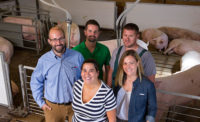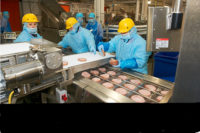
When John Butts, Ph.D., vice president of research at Land O’Frost, received the American Meat Institute Foundation (AMIF) Scientific Achievement Award in the fall of 2009, AMI president and CEO Patrick Boyle noted Butts’ profound effect on the food-safety efforts across the meat industry.
In the news release announcing the award, AMIF also commended Butts for “embracing the philosophy that food safety should be a non-competitive issue.”
Much like a great player on a successful sports team, Butts is honored to win the award, but he reveals that the teamwork and the corporate culture of food safety instilled in the Land O’Frost workforce deserves as much applause as he has received.
“Food safety is really engrained in the culture here, obviously based on the buy-in from top to bottom,” he explains. “If my award does nothing more than help our employees get that recognition, then that award was truly meaningful.”
Facts vs. perception
Many companies talk about food safety as being a top priority in their processing facilities, and indeed, many plants have succeeded in keeping product safe and secure for consumers. But some plants truly don’t grasp all that is necessary for a truly safe product to ship to market consistently.
The science of food safety must merge with the people skills of management in order for a company to maintain a stellar, spotless record - a history that Lansing, Ill.-based Land O’Frost has been fortunate to have.
“Perception is often so elusive to those of us who work in a science-based field, but food-safety management requires us to accept and recognize perception, frankly, for what it is,” Butts says. “Food-safety management also requires us to affect the perception of our company and our employees about food safety. I believe it’s probably one of the most unspoken and undocumented - and frankly, not recognized either - component of the job description of a food-safety manager or quality manager.”
Indeed, not every company has taken the required steps to make that happen. Michael Wammack, facilities maintenance manager in the Searcy, Ark., plant, believes that most everyone in the industry understands what “safety” is, but many become confused as to what “food safety” really means. From a maintenance perspective, food safety requires a lot of details and planning.
“One relationship that must be developed to have an effective food-safety program is the relationship between the food-safety manager, quality manager and the maintenance manager,” he explains. “Once this trio understands each other’s role, it makes life much easier to control construction projects and detail everyone’s responsibilities.”
Wammack believes that the managers filling those roles at Land O’Frost are industry leaders and have learned a lot through the company’s continuous improvement efforts. Butts agrees that this dynamic helps drive food safety and keeps facilities sharp in terms of keeping it atop the priority list.
“The food-safety job is not done when the report is filed and presented to top management,” he adds. “The job of the food-safety manager or CEO of a company is to create an environment that drives the food-safety culture, protects the consumer and prevents food-safety problems.”
The four phases of food safety
Land O’Frost stands as a perfect example of how successful such a shift in strategy can be. According to Butts, Land O’Frost shifted its strategies surrounding food safety in the late 1980s, under then-CEO Paul Van Eekeren, when the management team began proactively engaging employees in the importance of food safety and their responsibility to ensuring it.
“We have been fortunate to not have had to experience any major recalls or consumer events,” explains Brandon Dunn, production superintendent at the Searcy facility. “I believe our proactive and preventative approach toward Listeria control has proven to be the right thing to do.”
During the AMI Listeria workshops, Butts and the team educates attendees on the four phases that describe a company’s evolution toward doing “the right thing,” specifically in regard to pathogen control. Those four phases are Awareness, Enlightenment, Preventive and Predictive.
Land O’Frost has gone through these phases one by one.
“We’ve tried to take our Listeria control program from protecting consumer safety by product sampling to trying to identify where the problems start, finding something that we can measure to tell us when we need to apply an intervention, or taking a piece of equipment apart piece by piece and sanitizing each piece,” Butts adds.
In the Awareness phase, a company gets geared up to sample product to control Listeria. People recognize Listeria exists, but they want to control it by controlling the product.
“You keep hearing, everywhere, ‘We have to sample product. We have to sample product,’” Butts explains, “but people who are process thinkers see right through that strategy.”
The company that has moved beyond the Awareness phase into the Enlightenment phase has discovered a problem, as well as a root cause for the problem. The company then realizes there are some issues that need to be fixed or redesigned.
The next phase, the Preventive phase, has the company taking steps focused on eliminating the chance for the problem to recur, and the Predictive phase takes prevention one step further by recording measurements and reacting to that data.
Culture club
Total buy-in from the employees, top to bottom, is what Christine Hurckes, food safety manager at the Lansing, Ill., facility, believes has driven Land O’Frost to its food-safety success and solid reputation thus far.
“That is what the culture is - it’s everyone, not just one person. It’s not just one technical group responsible for it,” she says. “From my perspective, I’m here to cultivate thinking using scientific reasoning and methods to guide food safety; but as far as the responsibility for the culture of food safety, that’s everyone’s job.”
One of the ways in which employees can take charge of food safety is through Land O’Frost’s proactive S&D (Seek & Destroy) Team. The S&D Team maintains and continuously improves the equipment design, Sanitation Process Control procedures and operational GMPs, and also provides corrective and preventative action for any microbiological monitoring issues.
Simply put, “the S&D Team has the authority to cause things to happen,” explains Steve Jones, plant packaging maintenance manager at Searcy. Each team (one in each Land O’Frost plant) is comprised of managers and supervisors from production, maintenance, engineering, food safety and sanitation, and meets weekly. The S&D Team investigates any new equipment and breaks it down to check for a sanitary design that will support cleaning of the machine.
Engineering can offer support if the equipment does not meet the standards of sanitation, says Mable Woods, lead supervisor of sanitation in Lansing. But thorough investigation of equipment doesn’t end after the machinery hits the plant floor.
“We then perform missions monthly where we go out and tear a piece of equipment apart - it may be a piece that has been here for years even,” Woods explains. “We’ll go out there and take that equipment all the way down to nothing, swab and get the results back to see if it’s something we need to get into, needs routine cleaning or the design needs to be changed.
“Then, whatever needs to happen will happen,” she adds.
Data-based
Supporting Land O’Frost’s food-safety efforts is the crown jewel of the scientific side - data. Reams and reams of data has been (and continues to be) measured, collected and archived by the Land O’Frost team - albeit through an extremely powerful computer program and system, developed, maintained and improved by Srba Stancov, information services programmer in Lansing.
Stancov was opening blocks and grinding meat in the formulation department at the Lansing facility eight years ago when Butts learned of his background in computer programming. The duo began working together on small programming projects, building toward the eventual design of the all-inclusive data-management program the company needed for its food-safety initiatives.
“All routine sampling is incorporated into the application,” Stancov explains. “It works for us to manage and schedule how and when we sample which lines, all different kinds of analysis.”
The program automates and schedules tasks, develops work orders for technicians to go on the floor and take a sample, and then sends a pre-notification to Land O’Frost’s outside lab when a sample is ready for analysis. Once the results are posted in the laboratory system, the Land O’Frost computer uploads and automatically sends text and email notifications of any suspect or positive result. Butts says that the program has won over employees for its simplicity and ease-of-use.
“Srba engaged the technicians,” he explains. “He involved them directly in developing the program interface, and enabled them to feel a role in writing the program.”
With computing and data power behind it, Land O’Frost is able to keep employees fully involved in maintaining food safety, and Tim Robertstad, internal communications coordinator, believes that has helped keep the culture strong.
“There are a lot of jobs that are repetitive, and workers are encouraged to stay focused on what they are doing and to look around for things that might not be exactly right,” he says. “There’s also a theme around doing the right thing, and we recognize employees that spot things that might affect food quality or safety.”
Seeking the next challenge
Although pathogen control is a never-ending battle for any company, Land O’Frost believes it can take the same model and strategy it has developed in that fight to other projects tied to food safety and quality.
“We’re going to model what we accomplished with Listeria control into how we implement foreign-object control,” says Rocky McDurmont, superintendent of the Searcy plant. “That will be part of our strategic initiatives.
“We’re also very concerned about labeling accuracy, making sure each product is accurately labeled,” he continues. “Obviously, we have the allergen programs, but we’re going to spend time and effort to try to do the very best we can in error-proofing of systems.”
Land O’Frost also plans to continue working in cooperation with the industry on these food-safety issues and to apply those solutions in a positive corporate environment.
“When we come up with something good, we share it whenever we can,” Butts explains. “But we learn from others, too - gosh, we couldn’t come up with all the things we’re doing by ourselves.”
That open-forum style should keep Land O’Frost employees near the top of the food-safety awards list for years to come. Of course, while awards are good for the company’s reputation, employees never forget the real reason for their own buy-in to the program - a concept all food processors should adopt, and one that Woods says is reinforced continuously.
“One of the main things that we [train is], each time we produce product, that product is going out to customers who are your children at school, or family that lives in other states, and you want that ham or turkey sandwich they eat to be safe and wholesome,” she concludes. “In order to do that, you have to make sure you follow all the guidelines here.”
At Land O’Frost, the marriage of science and culture ensures that food-safety guidelines will be followed and are the real No. 1 priority for the company.
Photos by Vito Palmisano



Report Abusive Comment